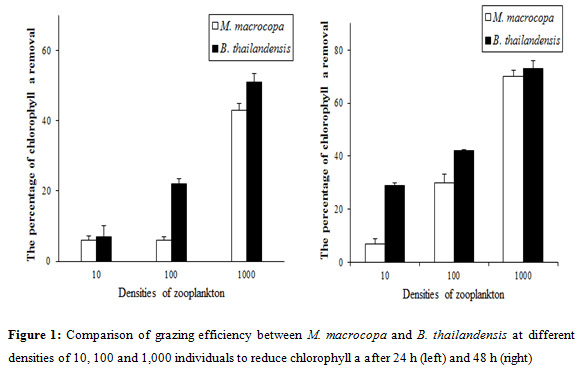Comparative Study of Grazing Efficiency between Moina macrocopa and Branchinella thailandensis to Control Phytoplankton Growth
Main Article Content
Abstract
Excessive growth of phytoplankton due to the addition of plant nutrients causes several negative impacts and lowers ecological values of water bodies. The concept of top-down control by zooplankton may help restore nutrient-enriched water bodies, already dominated by phytoplankton since zooplankton species have direct and substantial effects on phytoplankton communities through grazing. Therefore, in this study, an experiment to control phytoplankton by native zooplankton species was carried out. The species that were comparatively studied included Moina macrocopa (small body) and Branchinella thailandensis (large body). The results showed that in water with an abundance of Chlorella obtained from pure culture, B. thailandensis at the density of 1,000 individuals lowered Chlorella by 73% in comparison with M. macrocopa, which reduced biomass of Chlorella up to 70% after 48 hours of experiment. Statistical analysis indicated that the grazing efficiency of both species was not significantly different (p>0.05). Further investigation was carried out by using natural water collected from three nutrient-enriched ponds (namely A, B and C) at Kasetsart University. The experiment was set up for five days in the laboratory and it was discovered that after only two days, both species
of zooplankton had reached maximum grazing efficiency and decreased phytoplankton populations. M. macrocopa reduced chlorophyll a in water collected from A, B and C up to 90.5%, 95.6%, and 91.4%, respectively. Similarly, B. thailandensis had reduced chlorophyll a to the following concentrations of 93.7%, 86.4% and 82%, respectively.
Article Details
Published articles are under the copyright of the Environment and Natural Resources Journal effective when the article is accepted for publication thus granting Environment and Natural Resources Journal all rights for the work so that both parties may be protected from the consequences of unauthorized use. Partially or totally publication of an article elsewhere is possible only after the consent from the editors.
